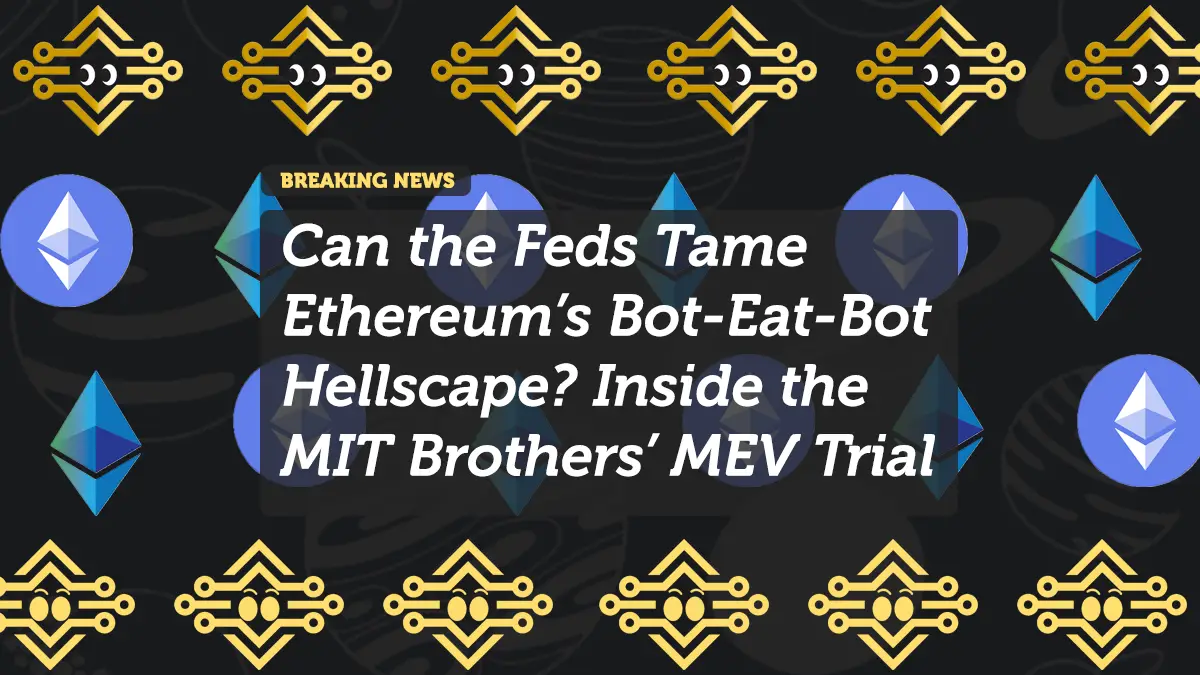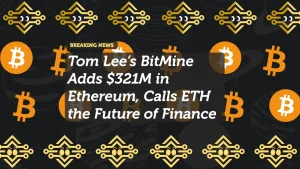
Can the Feds Tame Ethereum’s Bot-Eat-Bot Hellscape? Inside the MIT Brothers’ MEV Trial
The Core of the Story
This headline refers to an ongoing federal court case in the United States involving two MIT-educated brothers — Anton and James Peraire-Bueno — who were arrested in 2024 and charged with wire fraud and conspiracy for allegedly manipulating Ethereum’s transaction process to steal millions of dollars through a MEV exploit.
It’s one of the first times that U.S. prosecutors have tried to apply traditional financial crime laws (like wire fraud) to on-chain behavior, particularly to the dark and competitive world of Ethereum “MEV bots.”
What Is MEV? (Maximal Extractable Value)
- MEV stands for Maximal Extractable Value — profits that can be extracted by reordering, inserting, or censoring transactions in a block before it’s finalized on a blockchain like Ethereum.
- It’s the crypto version of Wall Street “high-frequency trading” (HFT) — except it’s more open and chaotic.
- Bots constantly scan the network mempool (where pending transactions live) and compete to front-run, sandwich, or back-run other transactions to profit from price slippage or arbitrage.
This has created what’s often described as Ethereum’s “bot-eat-bot hellscape” — a digital battlefield where algorithms fight to extract value faster than others, often at the expense of ordinary users.
The MIT Brothers’ Alleged Exploit
In April 2023, U.S. prosecutors allege that Anton and James Peraire-Bueno, both graduates of MIT’s engineering and computer science programs, found a way to exploit the MEV system itself.
Here’s what they allegedly did:
- They infiltrated a private MEV bot network used by validators to sequence and order transactions on Ethereum.
- They identified a vulnerability in how block proposers shared transaction bundles (via the Flashbots relay system).
- They intercepted and copied encrypted bundles from other MEV bots before they were executed.
- Using those copied transactions, they created fake blocks and reordered the bundles in their favor — effectively stealing $25 million worth of crypto in 12 seconds.
Prosecutors called this one of the most sophisticated “digital heists” ever conducted on Ethereum.
The Legal Stakes
The Department of Justice (DOJ) charged the brothers with:
- Conspiracy to commit wire fraud
- Wire fraud
Each count carries up to 20 years in prison.
But the deeper issue isn’t just what they did — it’s how the law applies.
Ethereum’s transaction mempool and block building processes are public infrastructure, not private property.
So the defense argues:
“They didn’t hack or deceive anyone. They used publicly available information on a decentralized network.”
Meanwhile, the DOJ argues:
“They manipulated the system to steal assets from other participants — it’s theft, no different from insider trading.”
This verdict could set a historic legal precedent for how MEV activity and crypto trading bots are regulated in the United States.
Why the Feds Care
The U.S. government — especially agencies like the SEC, CFTC, and DOJ — has been intensifying scrutiny on Ethereum’s internal market structure.
- Ethereum has evolved into a financially dense ecosystem, with billions of dollars moving through automated systems daily.
- MEV bots sometimes extract value from normal traders, making transactions more expensive and less predictable.
- Some bots even sandwich user trades — placing one transaction before and after a victim’s trade to profit from price changes.
Regulators see this as unregulated market manipulation — even though it’s technically allowed by Ethereum’s code.
So if the DOJ wins this case, it could pave the way for broader regulation of how Ethereum validators, relayers, and MEV bots operate.
Why It’s Complicated
Ethereum’s design intentionally allows open competition in transaction ordering.
Developers have long debated:
- Should the protocol limit MEV?
- Is it “unethical” or just an unavoidable feature of decentralized markets?
Ethereum co-founder Vitalik Buterin has acknowledged the MEV problem, calling it a “dark forest” where bots prey on each other and on unsuspecting users.
Projects like MEV-Boost, Flashbots Protect, and SUAVE (Shared Universal Auction for Value Expression) are attempting to make MEV fairer and more transparent.
But this case could throw a wrench into that progress.
If courts rule that manipulating MEV order flow constitutes wire fraud, it could make developers and validators legally liable for the behavior of their code or relays.
Potential Outcomes
- If the brothers are convicted:
- It sets a precedent that some types of on-chain manipulation are legally “fraud.”
- The DOJ could begin targeting other MEV participants, especially those using sandwich bots or exploiting slippage.
- It would push Ethereum toward stricter compliance frameworks — possibly centralized monitoring of transaction order flows.
- If the brothers are acquitted:
- It would reinforce the “code is law” principle.
- On-chain exploits, even when unfair, may remain outside traditional financial regulation.
- Ethereum’s MEV wars will continue — but so will innovation in “fair sequencing” tech.
Why It Matters for Ethereum’s Future
This case isn’t just about two MIT brothers — it’s about who governs decentralized finance.
If the feds win, it means the U.S. government is effectively asserting jurisdiction over how blockchains handle transactions.
That could reshape:
- Validator responsibilities
- Relay node operations
- Bot and algorithmic trading strategies
If they lose, it reaffirms the autonomy of decentralized systems — but leaves ordinary users exposed to predatory on-chain practices.
Either way, it’s a defining moment for Ethereum’s evolution from a “Wild West” experiment to a regulated financial infrastructure.
Bottom Line
Ethereum’s “bot-eat-bot hellscape” has long been a symbol of crypto’s unregulated freedom and technical chaos.
The Peraire-Bueno case represents the first serious attempt by the federal government to tame that chaos using traditional law.
The verdict — expected later this year — could determine:
- Whether MEV remains a technical quirk, or becomes a criminal offense.
- Whether Ethereum stays decentralized, or begins to comply with real-world market rules.
In short:
It’s the trial that could decide whether Ethereum’s dark forest stays wild — or gets fenced in.
















